As I mentioned in my Musical Inventor’s article about George Beauchamp, Hawaiian music was popular in the 1920s.
This was long before Hawaii became a state.
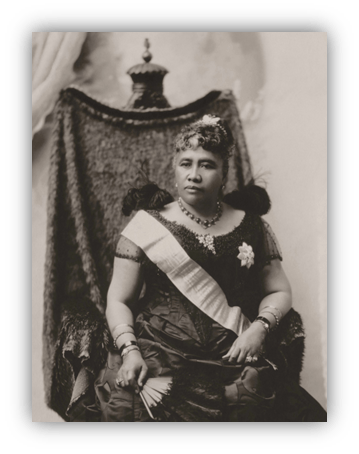
But it was only a few decades after the overthrow of Queen Liliʻuokalani, sponsored by the American sugar industry.
That’s a different story and not a pretty one, but it should be taught in every American high school.
Puerto Rico also produced a lot of sugar. But the sugar cane crop was devastated by two hurricanes in 1899. Farms took years to recover. Sugar businesses brought those unemployed Puerto Rican workers to Hawaii to increase the output there.
This produced a mix of Hawaiian and Puerto Rican music called Cachi Cachi.
It’s a true musical fusion because the Hawaiians didn’t speak Spanish and the Puerto Ricans didn’t speak Hawaiian or English, but they could communicate through playing music together. Blending their two cultures made something new.
That’s the simple version of how music evolves. By the 1920s, the Hawaiian music craze on the mainland didn’t actually have much Hawaiian in it. It had more to do with Jazz, Swing, and Country than it did with Hawaii before the annexation. But that’s the Hawaiian music Beauchamp and others loved, and it helped drive innovations to make the Hawaiian guitar, AKA the lap steel guitar, louder.
In Seattle, another young musician loved the sounds he knew as Hawaiian.
Paul Tutmarc was born in 1896 and learned violin, mandolin, guitar, and other instruments.
Like Beauchamp and Les Paul, he had a natural curiosity about the emerging world of electronics and mechanics.
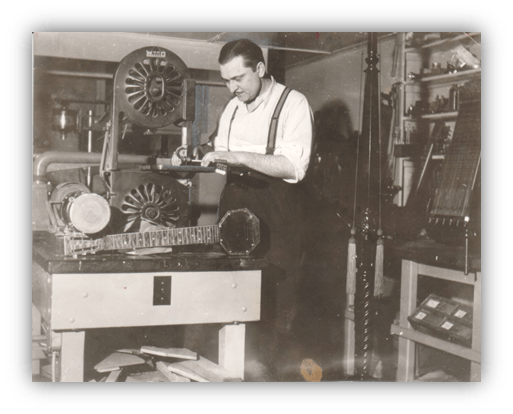
He wasn’t content to simply perform, he sought to improve the instruments he loved and overcome their volume limitations.
Also like Les Paul, Tutmarc was a child musician. Born in Minneapolis, he sang in his church choir and by 12 years old he was earning money playing music to help his family make ends meet. He started playing Hawaiian guitar at 15, and began touring.
At 21, he settled in Washington State. In addition to playing music, he worked in the shipyards in Aberdeen and Centralia. He was soon married and had a son named Paul Jr., though everyone called him Bud, and a daughter named Jeanne.
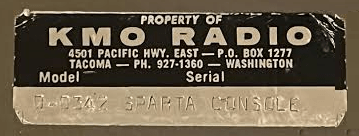
When he was 30, he became known as the “Silver Toned Tenor” on KMO, the radio station in Tacoma.
In 1928, the family bought a modest house in Seattle. It had a basement where Tutmarc experimented with electronics. He gave music lessons in the house, performed on KJR radio and at several theaters, and didn’t work in the shipyards again.
Dapper and charismatic, he won a role in a 1929 movie called It’s A Great Life.

While in Hollywood, he also appeared in The Voice of Hollywood # 7, a celebrity newsreel. However, he received no further offers and returned to Seattle.
Seattle had a thriving music scene.
As a port city, it brought in musical influences from all over the world and mirrored national trends, despite its distance from other cultural hubs. Its vibrant Jazz community brought in major touring stars like Paul Whiteman and Duke Ellington. This scene combined with the city’s industrial backdrop and its spirit of innovation was an ideal environment for a young musician and inventor like Tutmarc.
Beauchamp and Tutmarc probably didn’t know much about each other or any of the other homespun inventors.
But they knew about magnetic induction. And so they worked on developing a guitar pickup using magnets wrapped in wire. The first electric instruments each produced were solid body lap steel guitars, probably due to their love of Hawaiian music. There has always been some disagreement about who was first, but Beauchamp usually gets the nod.
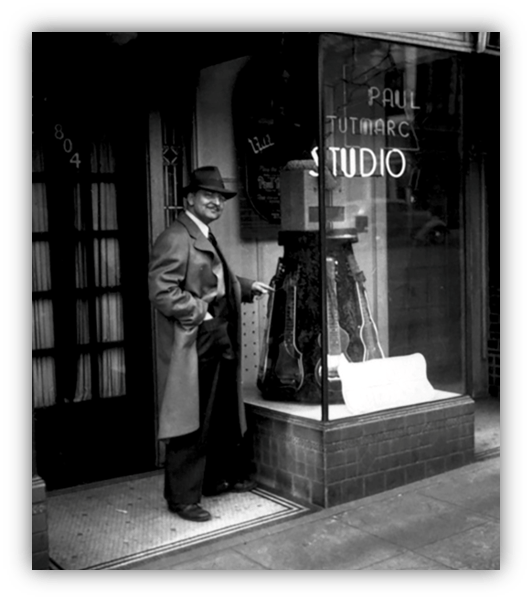
Tutmarc opened a music store and began giving lessons there rather than in the house.
He also began collaborating on experiments with Art Stimson, a hobbyist skilled in electronics.
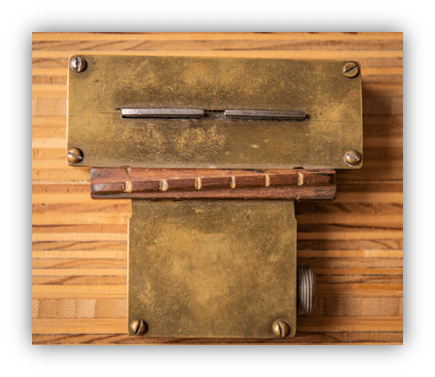
Together, they made a pickup by wrapping wire around an iron blade attached to a magnet.
They put it inside Tutmarc’s guitar and were astounded by its pristine sound. Right away, they understood its commercial potential.
Then the disagreement came.
Stimson wanted to immediately sell the design to instrument manufacturers. Tutmarc thought it best to keep it under wraps while they applied for a patent. However, their patent attorney did some research and told them the idea couldn’t be patented because it was too similar to telephone mouthpieces.

That advice cost them $300, or about $5,700 in today’s money.
Dejected, Stimson said he would try to interest others in the design and moved to Los Angeles. Tutmarc continued teaching and performing. He was, after all, one of the biggest stars in the Pacific northwest.
In 1933, an ad caught his attention.
The Dobro Manufacturing Company of Los Angeles was marketing an electric guitar. He thought it was odd that they would sell it without patenting it, and then discovered they had. Where he and Stimson had sought to patent the pickup, Dobro had patented the entire guitar. Either he and Stimson or the patent attorney didn’t think big enough. The attorney should have known better.
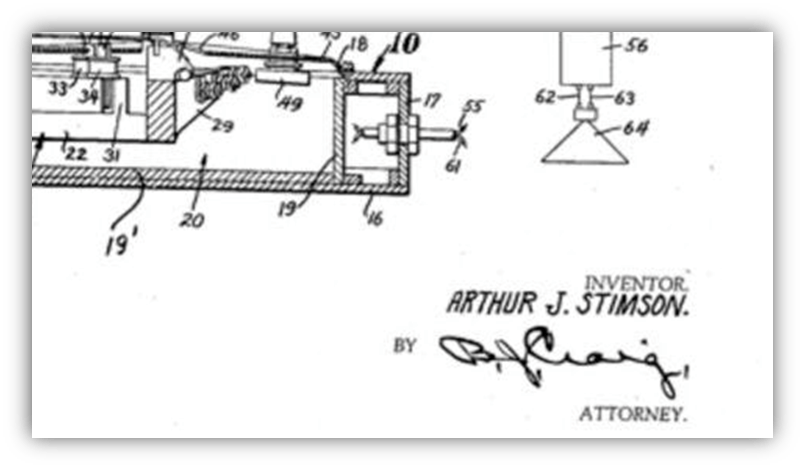
Even more hurtful, one of the names on Dobro’s patent was Art Stimson, who had sold the design to Dobro for only $600. And didn’t tell Tutmarc.
That spurred Tutmarc to start producing instruments, and to make better ones than Dobro or Electro Swing or any other manufacturer. He called it the Audiovox Manufacturing Company.
He improved the pickup design to use slanted, split pole pieces, thus creating the first “humbucker” pickup.
Humbuckers work by using two coils of wire wrapped around the magnet.

This effectively cancels out the unwanted electromagnetic hum you’ll sometimes hear on non-humbuckers, while maintaining a strong, clean signal. Dobro and the others began offering humbuckers, too.
The high quality of Audiovox’s lap steel guitars earned them a reputation as the best of the best.
Tutmarc’s friendship with famous lap steel players helped raise their profile.
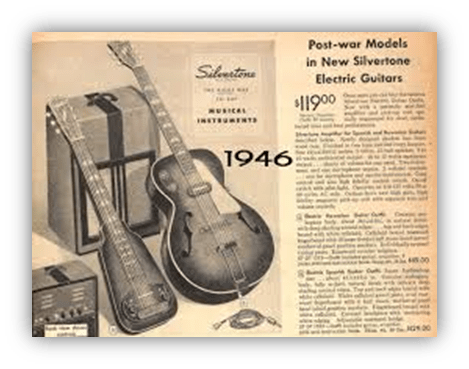
He also promoted the company by giving demonstration concerts in his own store and in others, like Sears Roebuck.
And he played his instruments on his weekly radio show.
All the while, he kept trying to innovate and Audiovox released many electrified instruments. In early 1935, they put out the “electric bull-fiddle.”
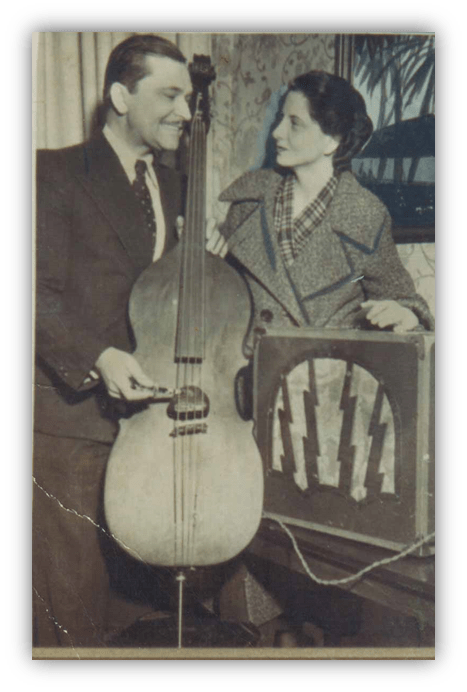
This produced the same low notes as an upright bass but was smaller, easier to transport, and louder.
For Tutmarc, this was a baby step towards the bass instrument he had in mind. He didn’t want to shock bass players, who he called a “conservative race.”
The instrument he wanted to make was released in 1936 as the Audiovox Model 736 Bass Fiddle.
Where his first model stood upright like a traditional bass, the 736 was played horizontally like a guitar
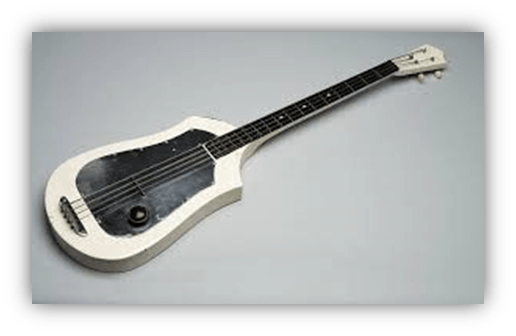
It also had frets, so the players’ fingering could be precise. And it had a solid body to avoid feedback. It even had a volume knob:
It was the first bass guitar.
Most musicians think Leo Fender invented the bass guitar.
What Fender actually did was popularize the bass guitar. Paul Tutmarc invented it, 15 years before Fender’s Precision bass guitar.
Those years may have made a difference in the 736’s success. Maybe it was 15 years ahead of its time.
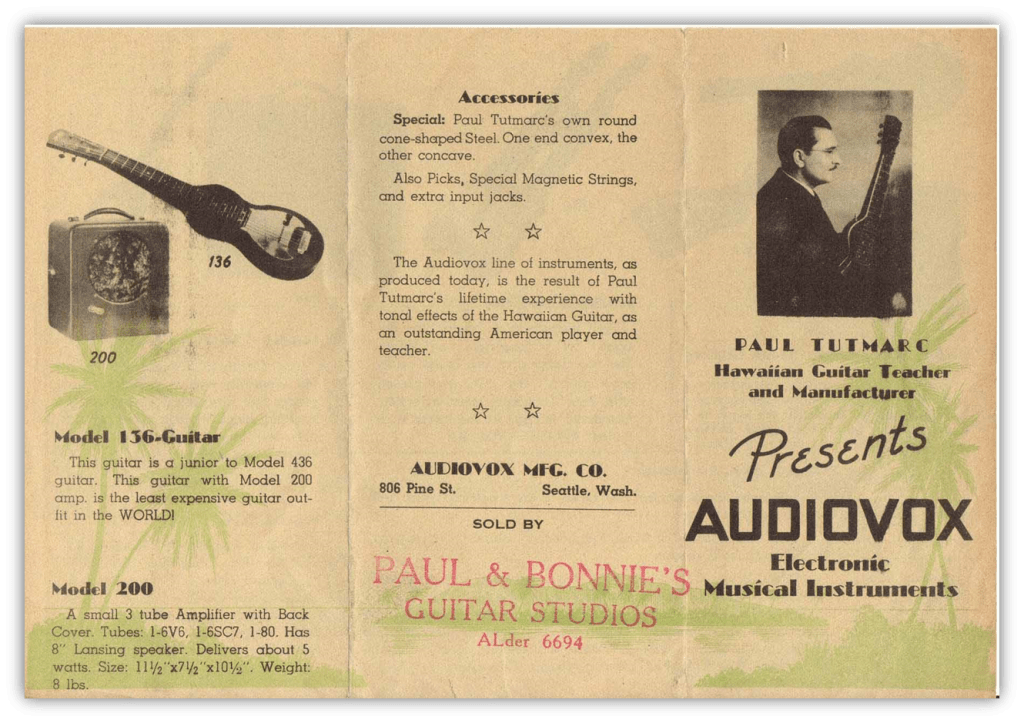
Tutmarc sold basses to musicians in the northwest, but it didn’t really sell anywhere else and Audiovox made no plans for national distribution.
We know of only four that still exist. One is in the Museum of Pop Culture in Seattle.
Tutmarc divorced his wife Lorraine in 1944 and married one of his guitar students the following year. Her name was Bonnie Buckingham but she performed under the name Bonnie Guitar. She was pretty, talented, and 27 years his junior. They started playing Country music as a duo or with a backing band. They had a few hits, like “Midget Auto Blues” and “Cowboy Serenade,” both written by Bonnie.
As good as Tutmarc was at promoting his instruments, he was also busy teaching, performing, recording, broadcasting, and running the store. If he had dedicated himself to performing, he and Bonnie might have had more hits. Had he given the 736 — and its matching 936 bass amplifier — more of a marketing push, they might be better known now.
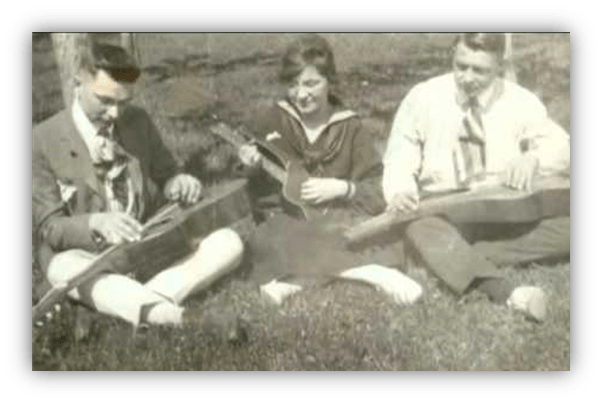
If he spent more time at home, he may have held his family together. He spread himself too thin and something had to give.
Audiovox stopped manufacturing guitars in 1950, the same year their daughter Paula was born.
Even so, the marriage fell apart and they divorced in 1955. Bonnie moved to Los Angeles and had a successful career with many hits.

She’s best known for 1957’s “Dark Moon” which hit #6 on Billboard’s Hot 100.
In the 1960s, Bonnie helped their daughter Paula record.

Using the stage name Alexys, she had a regional hit in Seattle’s hippie scene with “Freedom’s Child.”
Bonnie also helped her stepson Bud record his first album, Rainbows Over Paradise. He would go on to release two dozen albums of spirituals.

Bud’s grandson, Shane Tutmarc, is also a musician and had some success with his Seattle band Dolour.
He’s currently a singer, songwriter, and multi-instrumentalist living in Nashville.
Paul Tutmarc continued performing until the late 1960s, and kept teaching for the rest of his life.
His inventions — particularly the bass guitar — led to the rapid rise of Rock & Roll, which he didn’t like at all.
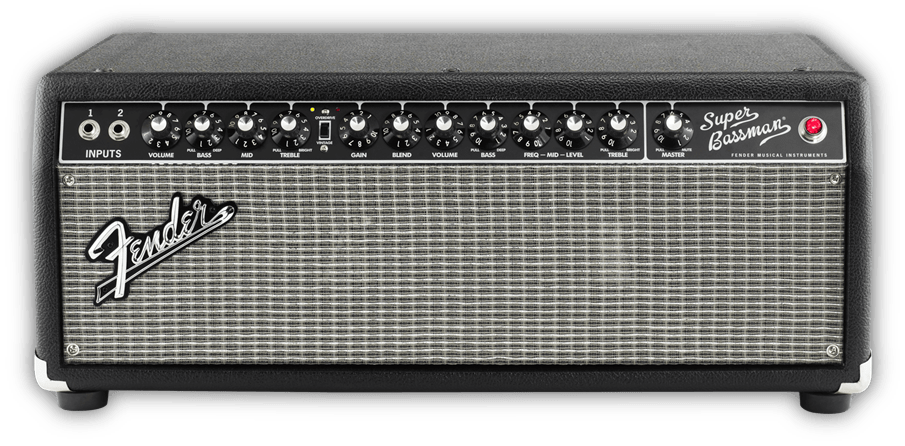
His hometown produced the loud and sloppy Garage Rock bands, like The Kingsmen and The Sonics, and the even louder Jimi Hendrix. Tutmarc acknowledged his role in Rock’s popularity, though was embarrassed by it.
In a 1972 interview shortly before his death from cancer, he said:
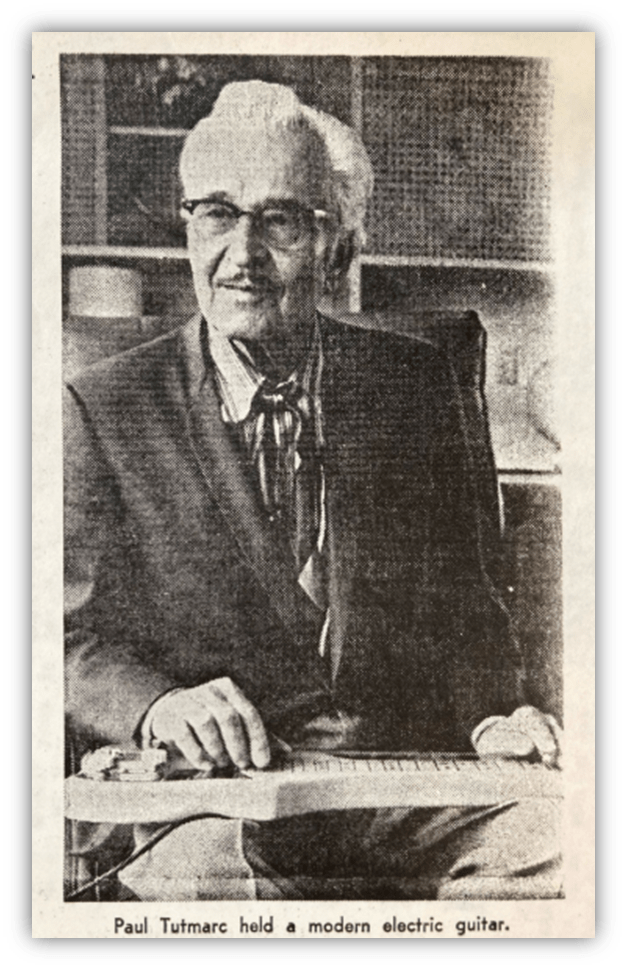
“A lot of fathers and mothers probably would like to kill me.”
Then again, if it hadn’t been me, it would have been someone else.”

Let the author know that you liked their article with a “Green Thumb” Upvote!


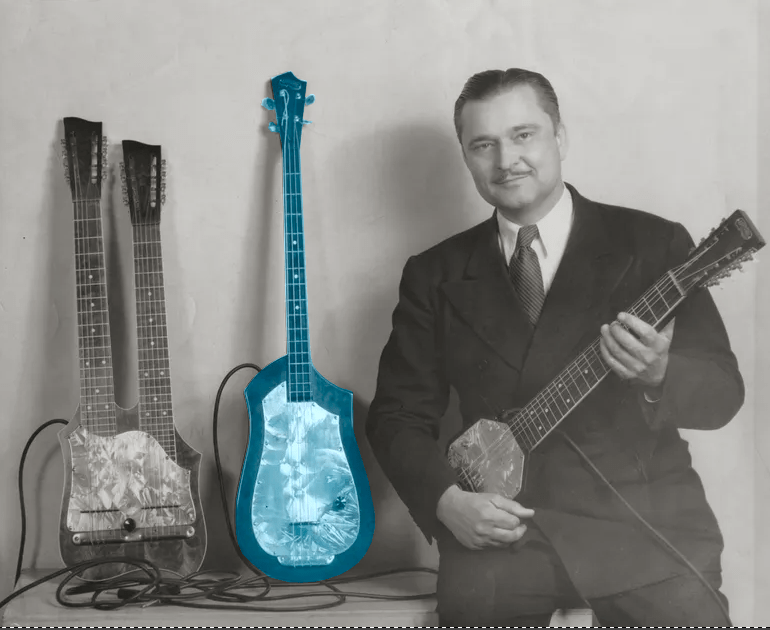






Lots of interesting information here. It’s nice to see the actual inventor getting his due. If he was still alive and still in Seattle, one doesn’t need to wonder what he would have thought of Nirvana, Pearl Jam, Alice In Chains, Soundgarden and the likes. Or it would have been funny if he just picked one band and hated all the others. “I like Mudhoney. The rest is garbage.”
It’s funny that he saw bass players as their own race and a conservative one at that. I will say that out of all instrumentalists I have known, bass players come the closest to having common personality traits though I wouldn’t include fear of innovation and change as one of them. Maybe it was different back then.
Ha! Mudhoney’s a good choice.
Bass players are always looking for better tone, so we love innovation. In Tutmarc’s day, they probably just wanted volume.
Makes sense. I have a teen bassist at church that normally plays electric, but she was playing an acoustic upright bass last week. We plugged her into the normal bass amp with a pick up and she said the tone of the bass was tinny and awful. I turned the mid and treble knobs all the way down, just leaving the bass frequency and it worked like a charm. I know nothing about this stuff, so we do the best we can and learn as we go.
It took me decades to figure out that it’s better to turn some frequencies down rather than turn others up, so you did good.
I heard the phrase humbucking pickup decades ago in relation to a guitar and had no idea what it was or did. 30+ year on the phrase comes back up and I finally have an answer. Thanks Bill!
Excellent as ever. Paul Tutmarc may not get the credit he deserves but sounds like he lived a full life and gave back by teaching all through it.
You’re welcome! I wrote this article just so you could have that answer.
That’s what I call good service.
Also, happy Barbershop Quartet Day!
Great job, Bill! I learned so much from this … not just about the instrument or the inventor but about American history re: the sugar trade. (I remember a nod to it in history class but nothing substantial.)